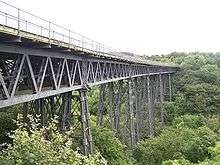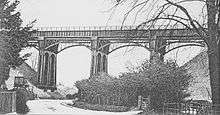Bennerley Viaduct
| Bennerley Viaduct | |
|---|---|
 The Bennerley Viaduct in 2010 | |
| Coordinates | 52°59′20″N 1°17′59″W / 52.988776°N 1.299691°WCoordinates: 52°59′20″N 1°17′59″W / 52.988776°N 1.299691°W |
| Carries | Ex-Great Northern Railway |
| Crosses | Erewash Valley |
| Locale | Nottinghamshire and Derbyshire Border |
| Maintained by | Sustrans |
| Heritage status | Grade II* listed |
| Characteristics | |
| Design | wrought iron lattice work |
| Total length | 1,452 feet (443 m) |
| Width | Twin Standard Gauge Rail |
| Height | 60.83 feet (18.54 m) |
| History | |
| Construction begin | May 1876 |
| Construction end | November 1877 |
| Opened | January 1878 |
Bennerley Viaduct is a disused railway viaduct spanning the Erewash Valley between Awsworth in Nottinghamshire and Ilkeston in Derbyshire. The viaduct is a Grade II* listed structure [1] and set to be restored and incorporated into a newly formed cycle-path. Small stages for the restoration started in mid 2014.

Origins

This wrought iron lattice work viaduct is 1452 feet long with the rails 60 feet 10 inches above the Erewash River. Most railway viaducts at the time were brick built but the foundations of the Bennerley Viaduct were subject to a great deal of coal mining subsidence therefore, the lighter wrought iron design was chosen. The viaduct was built between May 1876 and November 1877 and forms part of the Great Northern Railway Derbyshire Extension which was built in part to exploit the coalfields in Derbyshire and Nottinghamshire. The contract was given by the Great Northern Railway (GNR) to Benton & Woodiwiss with the line laid out by, and the viaduct designed by Richard Johnson (Chief Civil Engineer of the GNR); Samuel Abbott was the resident engineer. The viaduct consists of 16 lattice work deck spans, each 76 feet 7 inches long supported on wrought iron columns with stone capped blue brick foundations. There were three additional iron skew spans at the Ilkeston end of the viaduct which carried the railway line over the Erewash Canal and the Midland Railway's Erewash Valley Line.[2] A skew span crosses its abutments and or piers at an angle other than a right angle. At the Awsworth end of the viaduct there was a section of embankment (including bridges of more conventional brick construction) which has been demolished. The Nottingham Canal passed under this section. The viaduct was built for the railway line between Awsworth Junction and Derby on the Derbyshire and Staffordshire Line and opened in January 1878.[3] Bennerley Ironworks was originally due north of the viaduct served by sidings connected to both the Great Northern line and the Midland Railway Erewash Valley line. After the demolition of the ironworks a British Coal distribution depot served by sidings from the former Midland Railway occupied the same site. This has now also been demolished.[4]
Airship bombing raid

On 31 January 1916, nine Zeppelin airships of the German Airship Naval Division conducted a bombing raid over the British Midlands known as the Great Midlands Raid. One of these airships, the L.20 (LZ 59) based at Tondern in Schleswig (now part of Denmark) and commanded by Kapitänleutnant Stabbert, conducted a bombing raid in the area around the Bennerley viaduct. Seven high-explosive bombs were dropped in the vicinity, one of which fell just to the north of the viaduct on the Midland Railway line at Bennerley Junction, which served Bennerley Ironworks. Damage was caused to the Midland line, but the viaduct emerged unscathed.[5] Later during the same raid the L.20 dropped fifteen bombs onto the nearby Stanton Ironworks, one of which damaged a railway bridge crossing the Nutbrook Canal.[2] On 4 May 1916 after a second air raid over England, the L.20 ran out of fuel and crash-landed near Stavanger in Norway. [6]
Giltbrook Viaduct
At Awsworth Junction the railway branched, one line passed over the Bennerley Viaduct as described, the other turned North towards Pinxton crossing the Giltbrook Viaduct (or Kimberley Viaduct but known locally as Forty Bridges). This viaduct was also designed by Richard Johnson and built of red bricks used to create 43 arched spans with a total length of 1716 feet and a height of 60 feet.[2]
Other wrought iron viaducts


- The only similar viaduct in the United Kingdom was the Halesowen Joint Railway's Dowery Dell (Hunnington or Frankley) Viaduct demolished in 1964.[7] Other apparently similar structures were usually Warren Trusses, or (as in the case of Kew Railway Bridge), supported on cast iron cylindrical columns rather than wrought iron piers.
- The first Tay Rail Bridge used a similar latticework design. It collapsed during a storm in 1879 with the loss of 75 lives.
- One other wrought iron railway viaduct still stands in Britain. This is the Meldon Viaduct consisting of six, 90 feet (27 m) long Warren truss spans with a total length of 540 feet (160 m), 120 feet (37 m) above the valley floor built for the London and South Western Railway in 1874.[8]
- The dismantled Crumlin Viaduct finished in 1857 consisted of ten, 150 feet (46 m) long Warren Truss Spans 200 feet (61 m) above the valley floor built for the Taff Vale Railway extension. This was the tallest viaduct in Great Britain until its demolition in 1965.[9] This viaduct was used as a film location during its demolition whilst filming Arabesque.[10]
- The dismantled Belah Viaduct finished in 1861 consisted of 16 spans with a total length of 1,040 feet (320 m), 196 feet (60 m) above the valley floor, built for the South Durham and Lancashire Union Railway. This was the tallest viaduct in England. It was closed in 1962.[11]
- A wrought iron viaduct was built at West Meon on the Meon Valley Railway, opened in 1903. This 4-span viaduct stood 62 feet (19 m) high. Built to carry double track, the viaduct only ever carried a single line. The viaduct was demolished in 1955, and only the concrete pedestals and foundations remain.
- The Staithes Viaduct built for the Whitby Redcar and Middlesbrough Union Railway in 1875 and opened in 1883 was of wrought iron construction. It was dismantled in 1960.[12]
After closure

Bennerley viaduct's wrought iron construction saved it from demolition. The demolition contractors who tendered for the contract to demolish the viaduct put forward amounts which were considered too high. The reason given for the high cost was that wrought iron structures could not be cut up with an oxy-acetylene torch and would have to be taken apart rivet by rivet.[13] The viaduct survived to become a grade II* listed structure. The Meldon Viaduct was refurbished in 1996 and is now part of the Granite Way cycle and footpath in Devon.[8] Bennerley Viaduct is managed by Sustrans and may yet be used in the future as part of the national foot and cyclepath network in a similar way to the Meldon Viaduct.[14] It is on the Buildings at Risk Register.
See also
References
- ↑ "Name: BENNERLEY VIADUCT List entry Number: 1140437". Historic England. Retrieved 19 January 2016.
- 1 2 3 Henshaw, A. The Great Northern Railway in the East Midlands. RCTS.
- ↑ Nicholson, A. (28 December 2005). "Bennerley Viaduct, Awsworth". Images of Nottinghamshire.
- ↑ Lee, John.M. (2006). A Brief History of Awsworth (First ed.).
- ↑ "Air Raids" (PDF). The Voice of Trent Valley Aviation Society.
- ↑ New York Times (4 May 1916). "Zeppelin L.20 Lost" (PDF). The New York Times.
- ↑ D.J.Norton. "Dowery Dell Viaduct".
- 1 2 "Meldon Viaduct". Meldon Viaduct.
- ↑ Croeso, J. "Crumlin Viaduct". Crumlin Viaduct.
- ↑ "Arabesque film location".
- ↑ Bickerdike, G. "Belah Viaduct". Forgotten Relics of an Enterprising Age.
- ↑ Mell, K. "Staithes Viaduct". Subterranea Britannica.
- ↑ Gillespie, G. "Bennerley Viaduct". D.H.Lawrence's Eastwood.
- ↑ Prigg, B. "Railway Ramblers". Railway Ramblers.
External links
- "Friends of Bennerley Viaduct".
- Gillespie, G. "Bennerley Viaduct".
- Leverton, N. "Nottingham's Lost Railways".
- "Ilkeston Town Walks".
- "Ilkeston and District Heritage".
- "Sustrans".
- D.J.Norton. "Dowery Dell Viaduct Picture".
- Historic England. "Grade II* (352233)". Images of England.
- Historic England. "Grade II* (429388)". Images of England.
- Heritage at Risk: Bennerley+Viaduct
- Bennerley Viaduct on WikiMapia
- Fifteen photographs of Bennerley Viaduct
- Zepellin & Garrison Museum Tønder. "Zeppelin L.20".
- New York Times (4 May 1916). "Zeppelin L.20 Lost" (PDF). The New York Times.
- New York Times (3 February 1916). "Account of Great Midlands Raid" (PDF). The New York Times.
- The Argus. "Australian account of Great Midlands Raid".
- BBC. "BBC account on the Centenary of the Zeppelin raid.".
Further reading
- Kingscott, Geoffrey (2004). Lost Railways of Nottinghamshire. Countryside Books. ISBN 1-85306-884-5.
- Henshaw, Alfred (2000). The Great Northern Railway in the East Midlands. RCTS. ISBN 0-901115-88-6.
- Rayner Thrower, W. (1984). The Great Northern Main Line. Oakwood Press. ISBN 0-85361-297-8.
- Labrum, E.A. (1984). Civil Engineering Heritage, Eastern and Central England. Institute of Civil Engineers. p. 27. ISBN 0-7277-1970-X.
- Lee, John.M. (2006). A Brief History of Awsworth (First ed.).
- Corns, Danny (1999). Bygone Stanton. Andrew Knighton. ISBN 0-9533759-3-5.